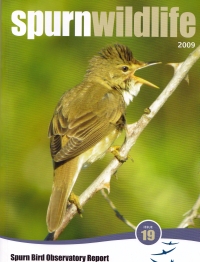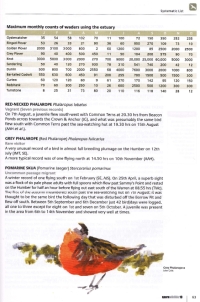Spurn Wildlife 2009

Picking up the Spurn Wildlife report is always an exciting moment, as it covers one of the country's prime migration sites. It is also blessed with a hardcore group of regulars who put seemingly endless effort into recording in true Bird Observatory style. Spurn must be blessed with (or suffer, depending on your viewpoint) vast numbers of visitors flooding in during the autumn, with reported sightings coming from all angles. Collating these records is no mean feat, and the observatory team does an excellent job.
On opening the report you can't fail to be impressed by how beautiful it is. It's not a word I often use in reference to a bird report, but the designers have done a fantastic job here. The photographs are stunning and the layout of the chapter headings — each with a full-page photo and open feel — really breaks the report up nicely. Add to this drawings by the talented Ray Scally (check the Wryneck on page 60 in particular) and the more stylized paintings of John Grist and this is a winning combination.

But what of the meat of the report? Does it tick all the boxes? It's good to see quite complete summaries of wader numbers and passage counts, but I did find myself flicking between the species accounts and the monthly summary to refer to the latter. The systematic list also has some great 'Did you know?' snippets, and no, I didn't know that at the banquet following the enthronement of Archbishop Neville in 1465, 2400 Ruff were served to guests. The level of details in the species accounts is a good reflection of the effort that goes into recording here and is in a format that makes interesting reading. There aren't many sites that report so completely, with breeding numbers given for all species, including the very commonest.
The 'bird gallery' has some great species, but some do appear to be a bit too small, with a lot of white space. There's a good mix of rare and scarce here, although I'm not sure I would have included the very fuzzy and bedraggled Subalpine Warbler — you can still just about tell it's an albistriata though.
The three accounts of birds new to the observatory give a great sense of the excitement involved in their finding. It's unusual to see identification articles in a bird report, but one by the impressive trio of Martin Garner, Roger Riddington and Magnus Robb on the ID of wing-barred Phylloscopus warblers is very well placed. The ringing section is well illustrated, and includes details of a great year. The totals of over 2000 Tree Sparrows is rather notable — though I hear that 2010 has been an even better year, with the previous record year of 11,435 (in 1988) easily beaten by October! Two long-overdue Red-flanked Bluetails were also notable.
But the cost of such a well-designed report is... the cost. This obviously has to be recouped somehow, and the plethora of advertisements is the solution. In an ideal world these would all be grouped together at the back, but what advertiser would want that? So they sit, sometimes rather uncomfortably, throughout the report. The ringing section seems worst affected, but perhaps this is where any advertiser would want to be, as naturally everyone is fascinated by ringing.... But the Dutch-ringed Common Redpoll (possibly only fourth foreign-ringed to be found in Britain and Ireland) looks a bit lost amongst country foods and civil engineering.
My only other criticism would be the rather obvious lack of any mention of mammals in the report. Butterflies, macro- and micro-moths, dragonflies and damselflies are covered, but not mammals. I'm sure they must be recorded, especially cetaceans from seawatches, so it's a pity they don't feature.
But all in all, this is a great report that would prepare any visiting birder with all the information they need for a visit. It truly whets the appetite, but be prepared to share your birding with a very large crowd at this prime site. With the closing of yet more accommodation at Spurn and the future of the planned new Observatory building in doubt, let's hope that the future of Spurn is rosy.
Copies of the report are available from Kew or the YNU visitor centre, costing £8 (+£1.25 p&p). Details on the Spurn website.


